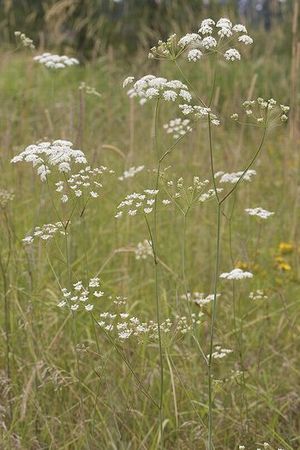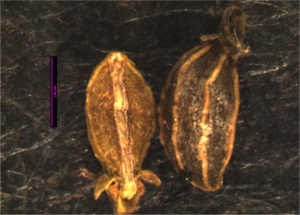Difference between revisions of "Perideridia montana"
(→The Seed) |
|||
| Line 1: | Line 1: | ||
[[File:Pega.jpeg|thumb|right|300px| ''Perideridia gairdneri'' <br/> Photo Credit Robert Gilbert]] | [[File:Pega.jpeg|thumb|right|300px| ''Perideridia gairdneri'' <br/> Photo Credit Robert Gilbert]] | ||
| − | ''Perideridia gairdneri,'' also called Gairdner's yampah, common yampah, or Gardner's yampah is a flowering plant in the | + | ''Perideridia gairdneri,'' also called Gairdner's yampah, common yampah, or Gardner's yampah is a flowering plant in the carrot family (Apiaceae). |
==Taxonomy== | ==Taxonomy== | ||
Revision as of 11:02, 7 May 2012
Perideridia gairdneri, also called Gairdner's yampah, common yampah, or Gardner's yampah is a flowering plant in the carrot family (Apiaceae).
Contents
Taxonomy
- Kingdom - Plantae – Plants
- Subkingdom - Tracheobionta – Vascular plants
- Superdivision - Spermatophyta – Seed plants
- Division - Magnoliophyta – Flowering plants
- Class -Magnoliopsida – Dicotyledons
- Subclass - Rosidae
- Order - Apiales
- Family - Apiaceae – Carrot family
- Genus - Perideridia
- Species - P. gairdneri
Description
P. gairdneri is a thick, tuberous rooted perennial herb that is slender and hairless. It has solitary, leafy stems, and grows from 40 - 120 cm tall. It has several, well distributed leaves that are once or two times pinnately divided into long, narrow segments. Flowers are white or pink and small, and are united in groups to form one to several compound umbels. Fruits are nearly spherical and slightly flattened, with distinct ribs. Fruits 2 - 3 mm long.
Source: Pojar pg 221
Bloom Period
July to August Source: http://biology.burke.washington.edu/herbarium/imagecollection.php
Distribution
Occurs from British Columbia to Saskatchewan, south across the Rockies and West Coast, down to Southern California.
Source: http://plants.usda.gov/java/profile?symbol=PEGA3
Habitat
Dry to vernally moist open forest, meadow, or grassy slope. Low to middle elevation.
Source: Pojar 221
Uses
Roots of P. gairdneri were eaten my Straits Salish and other First Peoples groups of the Northwest, and by interior peoples from south central British Columbia, to the great basin. The roots were pounded by native people to make flour.
Source: Pojar pg 221
Propagation
Photo Gallery
http://biology.burke.washington.edu/herbarium/imagecollection.php
References
The Seed
Peridendia gairdneri – PEGA
Seed sample from 2011
Features
Average Measurement: 2.3 x 1 x 1
Measurement Range: L: 1.5 – 3, W: 0.8 – 1.1, D: 0.75 – 1.3
Latitudinal Cross Section: ovate
Longitudinal Cross Section: elliptical
Shape: Seed schizoid, flat on one plane, and rounded on the opposite plane. Lots of irregularity in shape.
Color: Various shades of green and brown. Hilum usually white. Some seeds have pink from remnant flower structure at apex opposite hilum.
Surface: Seeds have five ridges on outer seed face that run from hilum to opposite apex longitudinally. Inner seed face has one white rib that bisects the seed face.
Basic Explanations and Assumptions:
The dimensions for the seeds are length x width x depth. The location of the hilum is used as the base of the seed, and the length is measured from hilum to the opposite apex. Where a style is present, the length is measured from the hilum to the bottom of the style. Width is measured at a right angle to the length at the widest part. Depth is measured at a right angle to the intersection of height and width lines.
Measurements included are the mean average for each measurement of ten separate seeds.
All measurements in millimeters unless otherwise noted.


